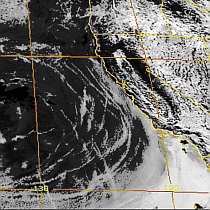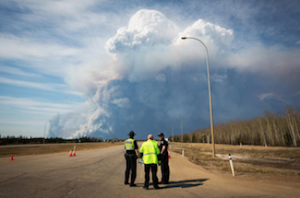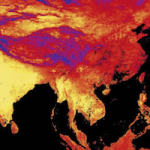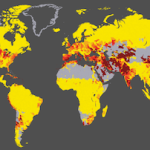“It’s Worse Than We Thought” — New Study Finds That Earth is Warming Far Faster Than Expected

Image Above: (Upper ocean heat anomaly map for 2002 through 2011 shows extreme global heating of the upper ocean during the past decade. Image source: Quantifying Underestimates of Long-Term Upper Ocean Warming.)
Source: Robert Scribbler
2 Degrees Celsius. That’s the ‘safe limit’ for human warming now recommended by the IPCC. But under current human greenhouse gas heating of the atmosphere and oceans, 2 C is neither safe, nor the likely final upper limit of the warming we will probably eventually see.
In the push and pull between all the various political and scientific interests over setting these goals and limits, the glaring numbers really jump out at the wary analyst. One is the total heat forcing now being applied to the atmosphere by all the greenhouse gasses we’ve dumped into the air over the years and decades. That total, this year, rose to a stunning 481 parts per million CO2 equivalent. And if we look at paleoclimate temperature proxies, the last time the world’s atmosphere contained 481 parts per million CO2 was when temperatures were in the range of 3-4 degrees Celsius hotter than we see today.
It takes time for all that extra heat to settle in, though. Decades and centuries for ice to melt, oceans to warm and the Earth System to provide feedbacks. So what scientists are really concerned with when it comes to recommending policy is how much warming is likely to occur this century. And, for this measure, they’ve developed a broad science for determining what is called Equilibrium Climate Sensitivity (ECS).
ECS is sensitivity to a given heat forcing that does not include the so-called slow feedbacks of ice sheet and ocean responses. For this measure, 481 ppm CO2e gets us to around 1.8 degrees Celsius warming this Century — if the Earth System and related so-called slow feedbacks are as slow to respond as we hope they will be…
Earth System Warming Far Faster Than Expected
Earlier this week, a new study emerged showing that the world was indeed warming far faster than expected. The study, which aimed sensors at the top 2,000 feet of the World Ocean, found that waters had warmed to a far greater extent than our limited models, satellites, and sensors had captured. In particular, the Southern Ocean showed much greater warming than was previously anticipated.
Winds and a very active downwelling, likely driven by a combined freshening of water near Antarctica and an increased salinity due to warming near the equator, drove an extraordinary volume of heat into these waters. An extra heat in the oceans south of the equator that was 24 to 58 percent higher than previous estimates. An extraordinary rate of uptake earlier measures had missed.
(Upper ocean heat content trends from 1970 to 2004. Note the extraordinary amount of heat being forced into the Southern Ocean near the 50 degrees South Latitude line. This heat forcing is likely due to increased storminess and ocean circulation-driven down-welling related to effects driven by human caused climate change such as increased glacial melt in Antarctica and increased sea surface salinity near the equator. Image source: Quantifying Underestimates of Long-Term Upper Ocean Warming.)
This observation led New Scientist to make the following rather blunt statement:
It’s worse than we thought. Scientists may have hugely underestimated the extent of global warming because temperature readings from southern hemisphere seas were inaccurate.
The implications of finding this extra heat are rather huge. For one, it upends current Equilibrium Climate Science. Gavin Schimdt — Chief NASA GISS scientist — over at RealClimate, noted that the study’s findings would increase ECS ranges from 1.4 to 2.5 C to 1.4 to 3.5 C. This increase shows that the Earth System may well be both far more sensitive to current human heat forcing and may well be likely to warm far faster this century than scientists had previously hoped.
Dr Wenju Cai from CSIRO in Australia added by noting that the results mean the world is warming far faster than we thought:
“The implication is that the energy imbalance – the net heating of the earth – would have to be bigger,” he says.
Higher rates of Earth Systems responses to human heat forcing this century and a larger net energy imbalance in the global system together spell very bad news. What this means is that there is both more heat forcing now than we at first expected and that that heat forcing is likely to bring about more extreme climate consequences far sooner than we had initially hoped.
These findings are new and will take some time to ring through the scientific community. And though this study provides a more complete picture of how rapidly the Earth is warming and where that heat is going, we are still missing another big part of the puzzle — what is happening to the deep ocean. Recent studies by Trenberth hint that that region of the climate system is also taking up extra heat very rapidly. So, hopefully, more exact measures of the total ocean system can give us an even better idea of how the Earth System is responding to our insults.
Yet again, we have another study showing clearly that conditions are today worse than we previously expected. How we can continue to do things like build coal plants and plan to burn oil and natural gas throughout the 21st Century is beyond imagining. But here we are…
Source: Robert Scribbler









































































































































Leave a Reply